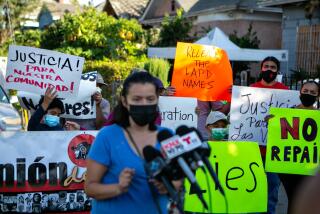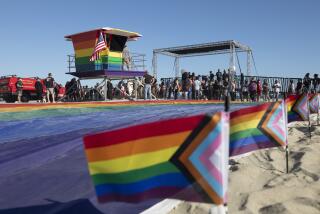He Recalls the Day the Beach Exploded
- Share via
The view was weirdly tranquil Monday through Capt. Bill Richardson’s window in Huntington Beach lifeguard headquarters. It was early afternoon, the beginning of the traditional last week of summer, but there was hardly a crowd on the beach.
The five-foot surf of the last several days, which would usually attract surfers, was chilled by strong breezes. The resulting chill and choppy waters were keeping most beachgoers away.
That, Richardson said, has been the story of the Summer of ‘87--cloudy, cool and crowds down maybe 10% overall. “Pretty lousy all summer,” he said.
So who’s complaining? Not Richardson, who remembers what it looked like out the same window exactly a year earlier.
On that day--Aug. 31, 1986--Richardson could barely see through the black smoke belching from a burning police car just below. What he could make out was a carpet of about 3,000 people crowded in front of lifeguard headquarters. About 50 of them were ripping and tearing and breaking what they could, and the others were cheering them on.
It was the infamous Huntington Beach riot, which broke out near the surfing contest the day before Labor Day and, before it ended, resulted in 40 injuries, 30 arrests and five police and lifeguard vehicles burned.
Richardson, 43, and third in command among Huntington Beach lifeguards, remembers the day vividly, for he remained alone in lifeguard headquarters after police and lifeguards retreated.
Until police returned to push back the crowd, Richardson held his ground, dodging rocks and bottles and metal rods broken from railings and lighted road flares. He confronted some who broke into the headquarters garage, began looting and, for a very brief moment, charged him as he stood in the doorway.
After a year of reflection, Richardson still doesn’t agree with his wife’s appraisal that his one-man stand was too much of a risk.
“I wasn’t willing to give up this building,” Richardson recalled. “There is a lot of stuff in here--radio equipment and computers and so forth. We couldn’t have just started up again the next day if we lost it all.”
He conceded he was angry: “Sometimes you don’t react rationally to something like that.”
Police said rioting began behind the bleachers at the surfing contest, when some boys or men pulled swimsuits off some girls or women. Police patrolling the beach went to break up the crowd and were driven back. The disorder on the packed beach escalated from there.
Videotaped scenes of the rioting, gathered by police from amateurs and broadcasters, at first show a handful of officers in an uneasy standoff with crowds of beachgoers. Then the videotape shows the officers slowly backing off the beach under the taunts and projectiles of the advancing, and increasingly hostile, crowd.
“When I looked out on the sand, it was the worst I have ever seen--I couldn’t believe it.” recalled Sgt. Patrick Clemens, who was the first sergeant on the scene.
“It was terrible, it was a nightmare, to see these people going berserk.”
Clemens said Monday he was convinced that sending his force of 20-30 officers into the crowd at that time would have resulted in bloodshed, that the officers would have been attacked and would have had to use their weapons.
Instead, Clemens said he ordered his men into the lifeguard headquarters. Shortly afterward, he was ordered to pull his men back from--and entirely out of sight of--the beach, in hope that the rioting would simmer down by itself.
Enter Richardson, who had been on the lifeguard headquarters roof watching rioters snatching yard-long, five-eighth-inch-thick, solid aluminum rods from a collapsed parking-lot railing. They were using them to break car windows.
Richardson said he saw one man bend a rod over the head of another man in the crowd who had been appealing to rioters to quiet down.
When the crowd spotted Richardson, he said they began throwing rods at him. “Their aim was terrible,” he said, but he went inside. There he saw police and lifeguards preparing to evacuate.
Richardson said he had to think about his decision to stay. Rocks were flying through the windows and lighted road flares were being tossed on the roof, but that was happening on only a section of the beach. Elsewhere, rescues were still being made in the surf, and so Richardson decided to man the communications switchboard and keep things going.
But first, he pulled the department’s 9-millimeter revolver out of storage, loaded it and strapped it on. Before then, the pistol had been used only during lifeguards’ firearms training, something all lifeguards undergo in case a firearm is found on the beach or a lifeguard must recover one dropped by a police officer during a scuffle, Richardson said.
“We want them to at least know how to safely handle one,” he said.
Police videotapes show what Richardson saw as he looked out his office window. Some youths were breaking everything breakable on the outside of a lifeguard pickup truck. Others were rocking a police patrol car and eventually overturned it. They jumped and danced in glee and gestured to the crowd.
A second patrol car was overturned. Two boys in the crowd stood in front of a close-up TV camera and held up two license plates apparently snatched from the cars.
Then in a TV long shot, the crowd quickly retreated from the building as the first police car began to burn, slowly at first, furiously after a short while.
“There,” said Richardson Monday, gesturing to the section of concrete still pocked by the heat.
Richardson said the lifeguard tower on the pier called and said rioters could be seen carrying equipment out of the headquarters weight-training room. Richardson said he cautiously looked into the room and saw that “they’d shredded the place” and were still at it.
“I just yelled at them to get out of there--expletives deleted--and they did,” he said. He relocked the door and bent some bars to reinforce the lock.
By then, he said, he was walking the halls with a fire extinguisher, waiting to put out any flares that made it through the windows. None did, but he soon noticed that the switchboard light for the garage phone was on. That meant it was off the hook, and that meant trouble in the garage.
Richardson said he went into a room beside the garage and opened a sliding panel about two inches so he could see inside. What he saw was 35-40 people going wild. They had forced open one garage door, then once inside had opened the others.
One was atop a pickup truck jumping up and down on the cab roof. The truck’s windows were gone, its headlights kicked in, its side mirrors ripped off.
The line of lifeguards’ bicycles hanging from the ceiling were gone. The cupboards along one wall were open, and their contents were being carried away.
Richardson said a debate was going on in his mind.
He could not yell through the window, because if the rioters came at him through the door from the garage, he’d be trapped in a room barely bigger than a bathroom.
But if he didn’t do something, they would destroy the garage, and perhaps spread into the lifeguard headquarters.
“If I let myself get backed against a wall, someone--them or me--was going to get hurt,” Richardson said.
He said he drew the revolver, opened the door to the garage, kept it open with the heel of one shoe, then shouted loudly and vulgarly for everyone “to get . . . out of here.”
Most stopped and looked, but two men started toward him, he said.
“So I fired a round,” Richardson said. The bullet hole is still visible in the garage ceiling, and the bullet is still lodged somewhere in a rafter or flooring.
The noise of the gun did the job. The small pistol with its big cartridges “makes a sound . It scared me. It served the purpose; this place emptied like the 100-yard dash.”
Ten minutes later, police returned to the beach and began to push the crowd back. The videotapes show a semicircle of empty sand extending almost to the water soon after police began their sweep.
A year later, Richardson said he remembers the slap and thump of the gunshot, the look and smell of burning cars, the anger at the assault on his headquarters, which was “like having someone break into your home.” He remembers looking through a crack into the garage as if peeking into another world.
But he remembers no faces, not even the ones who strode toward him in the garage. “I couldn’t identify them if you stood them in front of me,” he said. “I was just too overloaded at the time.”
And after lots of thinking and second-guessing, “I still feel pretty go about it,” Richardson said.
“The result is what we would have wanted: They left, and no one got hurt. I don’t know if I’d have shot anyone; I don’t know if I could. I’ve spent 26 years saving people’s lives. But I don’t want anyone to think I wouldn’t stop someone from taking my head off.”
Last year, the lifeguards’ pistol was stored in a locked cabinet, its ammunition in another, its holster in still another. Nowadays, it’s stored, together and loaded, in Richardson’s desk.
“The only thing we know is we’re not leaving our building again, even if police order us out,” Richardson said. “You can defend this place with one person.”
More to Read
Sign up for Essential California
The most important California stories and recommendations in your inbox every morning.
You may occasionally receive promotional content from the Los Angeles Times.










